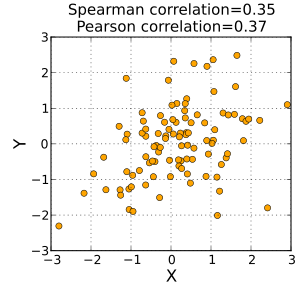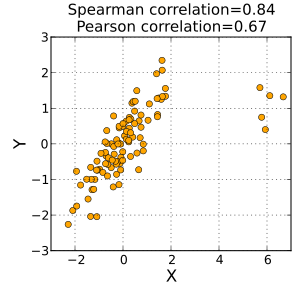


In statistics, Spearman's rank correlation coefficient or Spearman's ρ, named after Charles Spearman[1] and often denoted by the Greek letter (rho) or as , is a nonparametric measure of rank correlation (statistical dependence between the rankings of two variables). It assesses how well the relationship between two variables can be described using a monotonic function.
The Spearman correlation between two variables is equal to the Pearson correlation between the rank values of those two variables; while Pearson's correlation assesses linear relationships, Spearman's correlation assesses monotonic relationships (whether linear or not). If there are no repeated data values, a perfect Spearman correlation of +1 or −1 occurs when each of the variables is a perfect monotone function of the other.
Intuitively, the Spearman correlation between two variables will be high when observations have a similar (or identical for a correlation of 1) rank (i.e. relative position label of the observations within the variable: 1st, 2nd, 3rd, etc.) between the two variables, and low when observations have a dissimilar (or fully opposed for a correlation of −1) rank between the two variables.
Spearman's coefficient is appropriate for both continuous and discrete ordinal variables.[2][3] Both Spearman's and Kendall's can be formulated as special cases of a more general correlation coefficient.
- ^ Spearman, C. (January 1904). "The Proof and Measurement of Association between Two Things" (PDF). The American Journal of Psychology. 15 (1): 72–101. doi:10.2307/1412159. JSTOR 1412159.
- ^ Scale types.
- ^ Lehman, Ann (2005). Jmp For Basic Univariate And Multivariate Statistics: A Step-by-step Guide. Cary, NC: SAS Press. p. 123. ISBN 978-1-59047-576-8.





